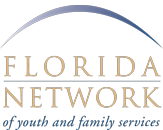
January is National Slavery and Human Trafficking Prevention Month. This month and every month, the Florida Network of Youth and Family Services strives to inform the community about this serious epidemic in order to prevent human trafficking as we continue to serve those who have fallen prey to this horrific brutality.
In recent news stories, you may have seen that the number of documented human trafficking cases in Florida in 2016 increased more than 54 percent from the previous year. The increase in reported allegations is due in large part to increased awareness through training and a new screening tool developed through the collaborative efforts of the Department of Children and Families (DCF), the Florida Department of Juvenile Justice and Florida Attorney General Pam Bondi. In addition, the state has implemented effective processes to crack down on the crime and document human trafficking charges.
DCF Secretary Mike Carroll shared in a news release that, “The increase in reports of human trafficking is evidence that the coordinated effort across state agencies to train professionals is increasing awareness and bringing more of the cases to light.”
The Florida Network of Youth and Family Services has played a significant role in this collaborative effort by hosting awareness panels and events, creating new protocols for minor sex trafficking, making sure our staff are properly trained in identifying victims and providing therapeutic services to help victims get back on their feet.
Furthermore, the Statewide Council on Human Trafficking implemented new training procedures for first responders and other child welfare professionals to help recognize the signs of human trafficking. So, what are the signs? Polaris does a great job of laying out some parameters that could help even the general public identify victims and move them toward receiving the assistance they need.
Everyone can play a part in fighting human trafficking.

